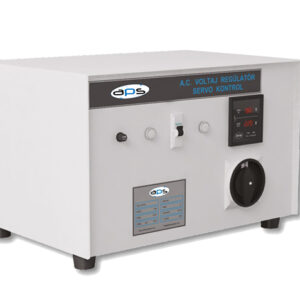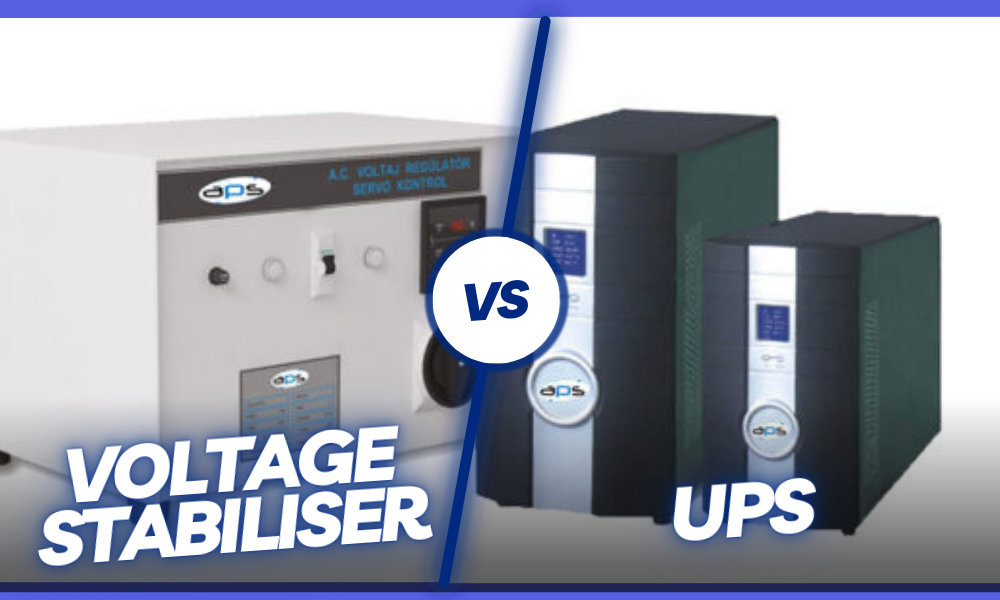Have you ever felt your heart sink as a sudden power fluctuation wipes away all your hard work, leaving you stranded in a void of lost data? The regret sets in. “Why didn’t I have any protection in place?” you ask yourself. Now, you find yourself standing at a crossroads, uncertain of which path to take for adequate protection. Should you rely on a voltage stabiliser, the stalwart defender, against voltage fluctuations? Or perhaps an uninterrupted power supply (UPS), the valiant guardian that keeps your devices running even in the darkest of times?
The answers lie within the secrets of these guardians, waiting to unveil the path that will safeguard your electronic realm and grant you peace of mind. While both manage voltage, their key difference lies in power outage response—UPS systems provide continuous power supply during outages, while Voltage stabilisers regulate voltage without backup power. Join us on a captivating journey as we unlock the mysteries, navigate through the darkness, and illuminate the way to protect your valuable work from the unpredictable storms of frequent power fluctuations.
Differences between UPS and Voltage Stabilisers
| Aspect | Voltage Stabiliser | Uninterruptible Power Supply (UPS) |
|---|---|---|
| Functionality | Regulates and stabilises voltage fluctuations within a predefined range. | Regulates voltage and offers a seamless switch to battery power during power cuts. |
| Backup Duration | Does not provide a backup energy source; it ensures stable voltage but doesn’t continue operation during outages. | Offers backup power, allowing electronic devices to run for a specific duration depending on the battery capacity. |
| Cost | Generally more cost-effective than a UPS. | Typically, more expensive due to additional components and battery backup. |
| Applications | Suitable for devices sensitive to power surge, such as TVs, refrigerators, and other home appliances. | Essential for critical equipment like servers, computers, medical devices, and other sensitive electronics that require continuous power even during outages. |
| Size and Weight | Generally smaller and lighter in size. | Larger and heavier due to the inclusion of a battery and inverter for backup power. |
| Maintenance | Typically, requires minimal maintenance. | The battery requires periodic checks and replacements, increasing maintenance needs. |
| Installation | Relatively simple to install and set up. | Requires more technical expertise during installation due to its complex setup. |
What is a Voltage Stabiliser?
A voltage stabiliser, also known as a voltage regulator, is an electrical device designed to maintain a consistent and stable voltage level supplied to connected electrical appliances or devices. Its primary function is to regulate the input voltage it receives from the main power source and provide a constant voltage output to the connected equipment. This device ensures that the voltage supplied to the electrical appliances remains within a specified and safe range, protecting them from potential damage caused by voltage surges.
Voltage stabilisers vary in type to suit different needs. Servo-Controlled Voltage Stabilisers use a servo motor and variable transformer for precise regulation, ideal for sensitive equipment. Relay-Type Voltage Stabilisers offer cost-effective voltage control for household appliances. Static Voltage Stabilisers, using solid-state electronic circuits, are efficient for critical applications. Automatic Voltage Regulators (AVRs) stabilise voltage in smaller appliances like computers and refrigerators.

How do voltage stabilisers work?
Voltage stabilisers operate by continually monitoring the incoming voltage from the main power supply. When fluctuations, such as voltage spikes (overvoltage) or drops (Undervoltage), arise, the stabiliser promptly adjusts the output voltage, maintaining a stable supply within the specified voltage range to the connected devices. Serving as a protective barrier, it prevents sudden or extreme voltage variations from reaching and potentially harming electrical equipment by ensuring a stable supply of power to the load.
What is an Uninterruptible Power Supply (UPS)
Is a UPS just a voltage stabiliser? Not quite! A UPS shares some similarities with a voltage stabiliser, but it’s a whole different beast. A UPS is a device that provides emergency power to a load when the input power source fails. The primary purpose of a UPS is to ensure continuous and uninterrupted power supply to critical devices, such as computers, servers, and other sensitive electronic equipment, in the event of power failure, voltage fluctuations, or transient disturbances in the main power supply, utilising the backup battery of the UPS to ensure seamless operation.
There are two main operational modes of UPS: online UPS and backup UPS. Online UPS systems continuously process incoming power through an inverter, providing seamless power and constantly charging the battery. On the other hand, backup UPS systems activate when power issues occur, swiftly switching to battery power to support connected devices.

How does UPS work?
UPS systems function by converting stored electrical energy from internal batteries or a flywheel system into regulated electrical power. Then, “Is it safe to run an LED TV on UPS?” Yes, when the UPS detects an irregularity in the input power supply, such as overvoltage, undervoltage, or a complete power outage, it swiftly switches to battery power or another secondary power outlet. This seamless transition ensures that the connected devices receive a steady and stable electrical supply, safeguarding them against disruptions and potential damage due to power surges.
Summing Up!
As we draw the curtain on the comparison between voltage stabilisers and UPS power supply, you might be wondering, “Which is better – voltage stabiliser or UPS power supply?” While both devices endeavour to shield your electronic domain from the turbulence of power instability, they possess unique abilities.
If your priority is ensuring a stable voltage supply for sensitive devices, the voltage stabiliser, acting as a vigilant protector, stands ready to regulate voltage spikes, ensuring a consistent power supply to your appliances. Conversely, when it comes to going beyond voltage regulation and providing a backup electrical source during outages to maintain uninterrupted device functionality, the UPS stands as an unwavering guardian and emerges as the superior choice.
Do not let power irregularities cast you into darkness or jeopardise your hard work. Arm yourself with reliable, top-tier solutions from Antipodes—our dependable voltage stabilisers and UPS systems fortify your valuable electronics with steadfast precision. Get in touch with us today to explore tailored power solutions that guarantee the safety and security of your electronics amidst power challenges.

